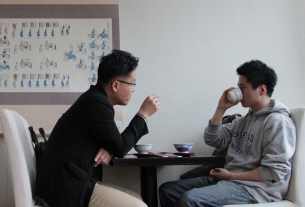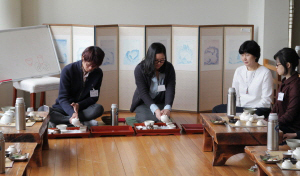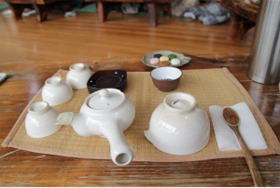 Caffe Pascucci, Twosome Place, the Mug, the Eyagi, the Lab, KAG... There sure are lots of coffee shops on the SNU campus! Some of us can't live without coffee, but how about a nice cup of tea once in a while? The teahouse Da Hyang Man Dang and its traditional tea can bring you comfort on a chilly day. The traditional teahouse which is located on the second floor of Building 67 opened in September 2009. It is the first traditional teahouse in the country ever to open on a university campus. The name, Da Hyang Man Dang (茶香滿堂), is derived from an eponymous poem written by the renowned Chosun dynasty scholar Da San Jeong Yak-Yong. It means 'the house is filled with the fragrance of tea'. Spreading the scent of tea around the campus, the teahouse lives up to its name.
Caffe Pascucci, Twosome Place, the Mug, the Eyagi, the Lab, KAG... There sure are lots of coffee shops on the SNU campus! Some of us can't live without coffee, but how about a nice cup of tea once in a while? The teahouse Da Hyang Man Dang and its traditional tea can bring you comfort on a chilly day. The traditional teahouse which is located on the second floor of Building 67 opened in September 2009. It is the first traditional teahouse in the country ever to open on a university campus. The name, Da Hyang Man Dang (茶香滿堂), is derived from an eponymous poem written by the renowned Chosun dynasty scholar Da San Jeong Yak-Yong. It means 'the house is filled with the fragrance of tea'. Spreading the scent of tea around the campus, the teahouse lives up to its name.
A place to drink tea, Da Hyang Man Dang is also a place of education. Twice a year, in March and September, it holds special lectures on ‘da doe (茶道)’, the traditional art of serving and drinking tea. In a special lecture given by Ryu Jeong-Ho on October 28, students were able to learn about the right way to use tea porcelain, the different kinds of teapots and the practical courtesies of making green tea.
How to Use Tea Porcelain
Mr. Ryu said green tea goes well with white porcelain unlike Oolong tea. On the other hand, powdered tea should be served with blue porcelain. Korean people tend to throw away teacups with cracks on the rim because they believe those cups bring bad luck. However, Mr. Ryu told the students that if there's no problem with drinking tea from the cup, they should keep it.
'Da Doe' for the Impatient Soul
 Two experienced students, one male and one female, demonstrated ‘hang da rye (行茶禮)’ for the class. Hang da rye is a traditional tea ceremony of making and drinking tea. It is otherwise known as ‘da doe’, which means ‘the way of tea’. It requires sincerity and concentration and exudes a calm and serene atmosphere. Hang da rye is performed by using two hands and the movements are different between women and men because they have different physical characteristics.
Two experienced students, one male and one female, demonstrated ‘hang da rye (行茶禮)’ for the class. Hang da rye is a traditional tea ceremony of making and drinking tea. It is otherwise known as ‘da doe’, which means ‘the way of tea’. It requires sincerity and concentration and exudes a calm and serene atmosphere. Hang da rye is performed by using two hands and the movements are different between women and men because they have different physical characteristics.
The traditional ceremony starts by placing the teaspoon in the corner of the tea tray. The combination of the reverent motions of the ceremony, the stationary posture and the rapid hand movements is like watching a gracefully choreographed dance. Keeping all the porcelains warm throughout the process is important because this enables one to enjoy the scent and taste of the tea until the very end of the ceremony. Pouring warm water into the cups one by one in a fluid motion helps keep the cups warm. During hang da rye, after pouring water into the bowl to make tea, one has to wait for the right amount of time. Between all the stages of hang da rye, there’s always a pause before moving on. That's why practicing this custom of making/serving tea can make even the most impatient person relaxed. During the class, students can also listen to traditional Korean music, which is another important component of da doe.
Different Kinds of Teapots
 There are three kinds of teapots: the front-handled, the side-handled and the top-handled. Mr. Ryu said that the most commonly used teapot is the front-handled teapot designed for right-handed people so left-handed people should avoid it. Teapots usually contain enough tea for three people, but in the case of beginners, the smaller the teapot the better. This is because if a beginner is drinking tea alone and using a big teapot, the fragrance of the tea will evaporate quickly so he won't be able to properly enjoy the tea’s scent and flavor. It is best for da doe beginners to drink alone, but after lots of practice and achieving the skills needed to use a teapot for three people one will be able to enjoy serving and drinking tea with friends.
There are three kinds of teapots: the front-handled, the side-handled and the top-handled. Mr. Ryu said that the most commonly used teapot is the front-handled teapot designed for right-handed people so left-handed people should avoid it. Teapots usually contain enough tea for three people, but in the case of beginners, the smaller the teapot the better. This is because if a beginner is drinking tea alone and using a big teapot, the fragrance of the tea will evaporate quickly so he won't be able to properly enjoy the tea’s scent and flavor. It is best for da doe beginners to drink alone, but after lots of practice and achieving the skills needed to use a teapot for three people one will be able to enjoy serving and drinking tea with friends.
Use Hangul instead of Classical Chinese
Many teashops in Insa-dong and Anguk-dong use classical Chinese characters. Mr. Ryu taught students both the Korean and the classical Chinese names of the tea utensils. By doing so the message he intended to send out is that in Korea, people should try to use Hangul, not classical Chinese characters. For example, we should use the word ‘cha soo jeo’ for teaspoon, ‘cha hang joo’ for tea cloth, and ‘chat joo jeon ja’ for teapot, not classical Chinese words like ‘cha shi’, ‘cha gun’, and ‘da gwan’.
There is a Cyworld club for people who took da doe classes at Da Hyang Man Dang (http://chasarang.cyworld.com). Those interested may join this site and receive more information about Korean traditional tea.
Written by JANG Hyo Jeong, SNU English Editor, fatalbonds@snu.ac.kr ?
Reviewed by Eli Park Sorensen, SNU Professor of Liberal Studies, eps7257@snu.ac.kr
Proofread by Brett Johnson, SNU English Editor, morningcalm2@gmail.com

